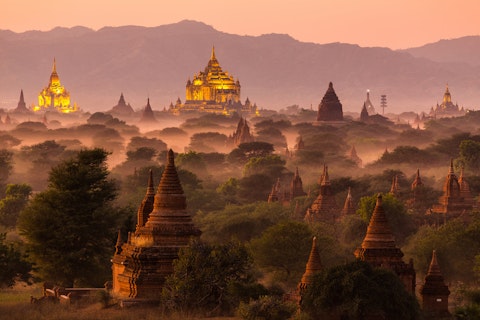In this article, we will take a look at the 15 most Buddhist countries in the world.
From ancient civilizations until the twenty-first century, with the variety and numerous religious organizations around the world, sociologists have found it difficult to define religion. Religions such as Christianity, Buddhism, Hinduism, Islam, and Judaism—the five prevalent religions in the world today—have been part of all people’s lives. In a standard sense, all people believe that religion is a set of beliefs, practices, and systems that most people relate to and associate with the belief of worshiping their god or another supernatural being that contributes to the spirituality of each individual. In addition, it is deeper than that; if you look at it and analyze it, it can also define the set of principles, the morality, and the ethical behavior of an individual towards another individual. Commonly, religion shares at least one characteristic with others.
Religion often relates to the distinct culture of each country. It influences society as a whole, encompassing the beliefs, traditions, customs, worldviews, norms, and way of life of each individual. In this recent period, religion has played an important role in an individual’s life and experiences. It can be a source of motivation, inspiration, and comfort to move forward with life when an individual is facing challenges and struggles in life. It can also serve as guidance to an individual to do good things for themselves and others, develop healthy habits, have optimism, regulate their behavior, and understand others’ emotions, where empathy is emphasized as a valuable characteristic of an individual. In society’s aspect, it provides a sense of community and connection to the cultural and traditional beliefs of each country. This suggests that it has an impact and influence on political decisions such as crafting humanitarian laws, justice, and equality for the common interest of the people in society.
As mentioned in the first paragraph, the prevalent religions around the world are Christianity, Judaism, Islam, Buddhism, and Hinduism. These religions spread worldwide through missions abroad, conquest, and colonization by preaching and teaching utilizing word of mouth. In this article, the main focus is on the religion of Buddhism. Buddhism originated on the continent of Asia, which is India. Buddhism is a religion and philosophy that developed from the teachings of Buddha, meaning “Awakened One.” Siddhartha Gautama is the founder from India who lived during the 5th century B.C. Likewise, it is renowned for its belief that “human life is one of suffering and that meditation, spiritual and physical labor, and good behavior are the ways to achieve enlightenment or Nirvana.”.
A brief background on Siddharta Gautama: he was born into a wealthy prince family in Nepal. He had an easy life until he realized and was moved by the suffering in the world. This led to a decision to give up his lavish lifestyle and endure poverty. Living and enduring poverty didn’t fulfill what he truly sought. Then, he promoted the ideology of the “middle way,” meaning that it exists between two extremes. Therefore, he sought a life without social indulgence but also without deprivation. After seeking enlightenment within six years, Buddhists believe that Gautama found enlightenment while doing meditation under a Bodhi tree. This led him to spend the entire rest of his life devoted to teaching about achieving this spiritual state. The teachings of Buddha became the foundation for developing the religion and philosophy of Buddhism.
Buddhism teaches that enlightenment describes the individual’s state of inner peace and will be achieved by waking from the sleep of ignorance and achieving freedom from suffering. Critics and scholars from around the world claim that Buddhism doesn’t acknowledge a deity or supreme god but is recognized as a philosophy, way of life, or spiritual tradition.
The teachings of Buddha are called “Dharma,” which encompasses qualities like wisdom, kindness, patience, generosity, and compassion. Following these moral virtues involves avoiding actions such as harming living beings, stealing, engaging in sexual misconduct, using harmful speech, and consuming intoxicants. Buddhism highlights the Four Noble Truths, which explain the nature of suffering (Dukkha), the cause of suffering (Samudaya), the end of suffering (Nirhodha), and the path to freedom from suffering (Magga). These truths serve as a guide to understanding why humans experience pain and how to overcome it. They form the basis of ethical conduct, mental discipline, and the pursuit of wisdom. Buddha termed these principles as the “Eightfold Path,” consisting of right understanding, right thought, right speech, right action, right livelihood, right effort, right mindfulness, and right concentration. This path provides a comprehensive framework for leading a balanced and fulfilling life.
Furthermore, Buddhists embrace the concepts of karma, which refers to the law of cause and effect, and reincarnation, which refers to the continuous cycle of birth. Highlighting the most notable practices and rituals of Buddhism. These are merit-making, bowing, chanting, meditating, and offerings that are done by Buddhists as part of devotion and veneration. It is truly wonderful that this religion and philosophy of Buddhism have significant impacts on individuals’ way of life, thoughts, behavior, and actions. Buddhism is one of the most prevalent religions in the world as people continue to believe and follow Buddha’s teachings.
There is no doubt that Buddhism is one of the big five religions worldwide, as it continues to spread and influence other countries, especially since its ideas and teachings are entering Western societies. Buddhism has taken many forms and exists. Although different types of Buddhism represent specific geographical areas, These types of forms have slightly different interpretations of Buddha’s teachings, as they incorporate other ideologies from different religions and philosophies. In drafting the 15 Most Buddhist Countries in the World, while researching and validating, it was found that most countries around the world practicing the customs and beliefs of Buddhism are in Asian countries. Alongside its representation of the specific geographical areas, the type or forms of Buddhism and how the people adapt and practice will be tackled.

Stephane Bidouze/Shutterstock.com
See also: Top 20 Countries with the Most Handsome Men in Asia
Our Methodology
In crafting the article, The 15 Most Buddhist Countries in the World, the researchers considered two criteria. The first criterion would be the selection of the countries. This will be based on the valid surveys conducted and the corresponding interpretation of statistics published by experts and scholars. This would be the primary criterion. Secondly, various sites and other further supplemental sources have been explored, read, studied, and extracted, showing the history to validate and support the claims of the countries that are included in the list. On top of it, essential information was added to strengthen its claim.
Check out our article on the 10 Best Places to Buy Cheap Cigarettes for insights on where to find discounted cigarettes. Additionally, explore our 25 Jobs that Pay 100k a Year article to discover high-paying job opportunities.
Without further ado, let’s now discuss the 15 most Buddhist countries in the world.
15 Most Buddhist Countries in the World
15. South Korea
Nowadays, essentially, the study findings show that fifty percent (50%) of South Koreans are now non-religious, or some are atheist and agnostic. Sixteen percent (16%) are Buddhist. Somehow, South Korea is included in the list of the 15 most Buddhist countries in the world due to their practices and way of life. This can be traced back to their history.
14. Malaysia
Buddhism is the second-largest religious denomination in Malaysia after Islam. There are approximately 5.4 million Buddhist adherents in the country, comprising nineteen-point two percent (19.2%) of our population of 28.3 million, according to statistics. The majority of them are ethnic Chinese who follow the Mahayana Buddhist tradition. Additionally, most Mahayana Buddhist temples in Malaysia adopt the classical ‘Chinese temple’ architectural style. The Mahayanists conduct their services in Mandarin and in various other Chinese dialects, although some urban-area temples have been preaching in English. The practice among the majority of ethnic Chinese who profess themselves as Buddhists is actually a mixture of Buddhism and Chinese beliefs and traditions.
13. Taiwan
Taiwan follows Mahayana Buddhism, which is a branch of Buddhism that emphasizes the ‘bodhisattva’ ideal of seeking full awakening through attaining perfection in morality and knowledge whilst endeavoring to assist others on their path towards enlightenment. In the contemporary period, Taiwan is predominantly a mixture of Buddhist and Taoist, with ninety-three percent (93%) of the population identifying with these traditions. Likewise, Buddhist education, organizations, and publications also testify to the strength of Buddhist practices in the region.
12. Macau
Macau is included in the list as one of the 15 most Buddhist countries in the world. Buddhism is the predominant religion in Macau, but it is not a state religion. The main religions in Macau are Buddhism, Roman Catholicism, and Islam. Buddhism constitutes the teachings of Chinese culture. According to statistics, about eighty percent (80%) of the population in Macau practices Buddhism. It has greatly influenced the culture and traditions of the residents of Macau. There are some influential Buddhist groups in Macau, and these groups are some of the most popular, namely the Macau Buddhism Society and the Macau Buddhism Union. You can also see many Buddhist temples in Macau, such as the Guanyin Temple and others, that are popular with tourists.
11. Tibet
This may seem unfamiliar to others, as this country is located near China and Mongolia. Religion is extremely important to the Tibetans and has a strong impact and influence on their overall lives. In the past, Bön was their ancient religion, but nowadays, Buddhism is the religion of the majority of Tibetan people. The Tibetan people have a distinct form of Buddhism that is basically different from Mahayana and Vajrayana. Therefore, it is considered one of the 15 most Buddhist countries in the world.
10. Vietnam
Due to the emergence and introduction of religions around the world, the most widely spread religions are Buddhism, Confucianism, Taoism, Catholicism, Islam, and Cao Dai in Vietnam. Buddhism is the leading religion in the country, with fifty-five percent (55%) of the population being Buddhist. The Vietnamese Buddhists emphasized and gave importance to mental and physical self-discipline and proper conduct instead of the painstaking acquisition of doctrinal knowledge. Therefore, the Vietnamese highly value Buddhism as their religion and part of their culture. Here are some of the famous Vietnamese Buddhist temples: Quan Thanh Temple, Tran Quoc Pagoda, Temple of Literature, Ngoc Son Temple, Perfume Pagoda, Ha Tay, But Thap, and One Pillar Pagoda, which are all located in the capital of Vietnam, Hanoi. Lastly, But Thap Pagoda in Bac Ninh and Tran Temple in Nam Dinh.
9. Singapore
Singapore is a diverse country with a wide range of nationalities, ethnicities, and cultural backgrounds. It may seem odd to others, as Singapore is included in the list of the 15 most Buddhist countries in the world. Its religious diversity is notable and remarkable on a global scale, especially in neighboring countries located in South and Southeast Asia. In a research report by the Pew Research Center, it was stated that few Singaporeans were from their original mainland, namely Malaysia, China, Indonesia, India, and Cambodia. The reason why Buddhism is a more dominant religion in Singapore Furthermore, on the internet, you can explore many temples and religious objects as tourist spots showcasing Buddhism as their religion.
8. Japan
It is a bit surprising that a country referred to as the Land of the Rising Sun, Japan, is included in the list as one of the 15 most Buddhist countries in the world. The majority of the population of the world knows that Japan’s religion is Shinto. Shinto may be described by Japanese as old as Japanese culture. Meanwhile, Buddhism was imported and introduced during the 6th century. Since then, Buddhism and Shinto have co-existed harmoniously, and their teachings complement each other. The reason why most Japanese consider themselves Buddhist, Shintoist, or both, meaning having two religions at the same time, Japanese are practicing Buddhism as manifested and exposed by their pop culture, TV shows, movies, series, and anime.
7. Mongolia
A few sites encountered, researched, and read by the researcher stated that in Mongolia, one of its tourist spots has to do with culture, particularly the two main religions of Mongolia. These are Buddhism and Shamanism. During the period from 1924 to 1992, the communist party suppressed all religions. All intellectual personalities, religious figures, or anyone who might contribute to or pose a threat to the communist party were killed or exiled to Siberia. This depicts that Buddhism is the most commonly practiced faith in the country, and religious leaders from a variety of faiths cited instances of negative public sentiment toward “foreign” religious groups, as they stated that the term mentioned was sometimes used to refer to non-Buddhist and non-Shamanist religious groups. This put Mongolia in seventh place among the 15 most Buddhist countries in the world.
6. Laos
According to Britannica (2023), sixty-four point seven (64.7%) of the Lao people are Buddhist. The remaining percentage were Christians, animists, and atheists. Therefore, it was concluded that it was the dominant religion in the country. In addition, Laos’ Buddhism is in the form or type of Theravada Buddhism. It was recognized and declared the official state religion. The Lao people living in rural areas are highly practicing Buddhist customs and beliefs. If someone travels to Laos, one thing that they will see is the monks, religious objects, and monks that are praying, meditating, or doing rituals in their sacred temples. Laos is regarded as one of the 15 most Buddhist countries in the world.
5. Bhutan
In the 15 most Buddhist countries in the world, Bhutan placed fifth. Buddhism, specifically Vajrayana, which is another type or form of Buddhism, has a special place and significance in the culture and national identity of the citizens. Bhutan is considered one of the most Buddhist countries in the world. Exemplary due to its people’s strong faith and values. Vajrayana Buddhism is the major school, and the government in Bhutan allows courts and other government institutions to remain housed in or adjacent to Buddhist monasteries. Likewise, religious groups said that government ceremonies will continue to involve mandatory Buddhist prayer rituals. The government also continues to recognize and acknowledge the mentioned religions as public holidays for significant events held about the practices and rituals in Buddhism. In contrast to the other religions, the government did not recognize any religious holidays as public holidays.

4. Myanmar
Almost ninety percent of the majority of the population in Myanmar practices the beliefs and customs of Buddhism. It is also the way Burmese people believe about their way of life and moral codes. Furthermore, throughout the history of Myanmar, Buddhism has already been part of their lives, which shows their state, particularly in the city where they live, where you can witness a lot of sacred houses and temples with monks praying, meditating, or interacting with other people. However, Myanmar recognizes other religions such as Christianity, Hinduism, Animism, and Islam, and there is no official state religion. Recently, the constitution has required the government to recognize the special position of Buddhism as the religion or faith professed by the majority of the people. Thus, Myanmar is included in the list of the 15 most Buddhist countries in the world.






